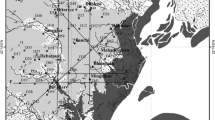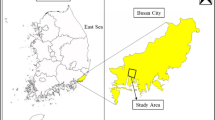Abstract
Although some liquefaction assessment methods were proposed to evaluate the liquefaction potential of sandy soils, the conventional method based on the standard penetration test (SPT) has been commonly used in most countries and in Turkey. However, it alone is not a sufficient tool for the evaluation of liquefaction potential. The liquefaction potential index was proposed to quantify the severity of liquefaction. Nevertheless, the liquefaction potential index and the severity categories do not answer the question: "Which areas will not liquify?" Besides, the categories do not include a "moderate" category; on the other hand, the "high" and "low" categories are included. This situation is also contrary to the nature of classification schemes. In this study, the liquefaction potential index and the liquefaction potential categories were modified by considering the existing form of the categories based on the liquefaction potential index. While the category of low was omitted, the categories of moderate and "non-liquefied" were adopted. A factor of safety of 1.2 was assumed as the lowest value for the liquefaction potential category of non-liquefied. In addition, the town of Inegol in the Marmara region became the case study for checking the performance of the liquefaction potential categories suggested in this study.









Similar content being viewed by others
References
Ambraseys NN, Adams RD (1992) Seismicity of the Cyprus region. Engineering Seismology and Earthquake Engineering Report No 92-9
Andrews DC, Martin GR (2000) Criteria for liquefaction of silty sands. In: Proceedings of the 12th World Conference on Earthquake Engineering, Auckland, New Zealand
Aydan O (1997) The seismic characteristics and the occurrence pattern of Turkish earthquakes. Turkish Earthquake Foundation Report TDV/TR 97-007
Aydan O, Sezaki M, Yarar T (1996) The seismic characteristics of Turkish earthquakes. In: 11th Proceedings of the International Conference on Earthquake Engineering, Acapulco, Mexico, pp 1–8
Aydan O, Ulusay R, Kumsar H, Tuncay E (2000) Site investigation and engineering evaluation of the Duzce–Bolu earthquake of November 12, 1999. Turkish Earthquake Foundation Report TDV/DR 009-51
Barka AA (1997) Neotectonics of the Marmara region in active tectonics of Northwestern Anatolia. In: Schindler C, Pfister M (eds) The Marmara Poly-Project, Hochschulverlag AG an der ETH, Zurich, pp 55–87
Doyuran V, Kocyigit A, Yazicigil H, Karahanoglu N, Toprak V, Topal T, Lutfi S, Yesilnacar E, Yılmaz KK (2000) Geological/geotechnical investigation of Yenisehir municipality settlement area (in Turkish). Middle East Technical University, Project No 99-03-09-01-02, Ankara, p 79
Fukushima Y, Tanaka T, Kataoka S (1988) A new attenuation relationship for peak ground accelerations. Proceedings of the 9th World Conference on Earthquake Engineering, vol 3, Tokyo, Japan, pp 343–348
Gencoglu S, Inan E, Guler H (1990) Earthquake hazards of Turkey (in Turkish). Chamber of Geophysical Engineers of Turkey, 701 pp
Gurbuz C, Aktar M, Eyidogan H, Cisternas A, Haesler H, Barka A, Engin M, Turkeli N, Polat O, Ucer SB, Kuleli S, Baris S, Kaypak P, Bekler T, Zor E, Bicmen F, Yoruk A (2000) The seismotectonics of the Marmara region (Turkey): results from a microseismic experiment. Tectonophysics 316:1–16
Inan E, Colakoglu Z, Koc N, Bayulke N, Coruh E (1996) Catalogue of earthquakes between 1976–1996 with acceleration records. ERD, General Directorate of Disaster Affairs of Public Works and Settlement, Ankara, Turkey, 150 pp
Iwasaki T, Tokida K, Tatsuoka F, Watanabe S, Yasuda S, Sato H (1982) Microzonation for soil liquefaction potential using simplified methods. In: Proceedings of the 3rd International Conference on Microzonation, Seattle, vol 3, pp 1319–1330
Joyner WB, Boore DM (1981) Peak horizontal acceleration and velocity from strong-motion records from the 1997 Imperial Valley, California earthquake. Bull Seismol Am 71(6):2011–2038
Liao S, Whitman RV (1986) Overburden correction factors for SPT in sand. J Geotech Eng ASCE 114(4):389–411
Saroglu F, Emre O, Kuscu I (1992) Active fault map of Turkey. General Directory of Mineral Research and Exploration (MTA), printed by MTA (scale:1/1.000.000), Ankara, Turkey
Seed HB (1983) Earthquake-resistant design of earth dams. Proceedings of the Symposium on Seismic Des. of Earth Dams and Caverns, ASCE, New York, pp 41–64
Seed HB, DeAlba (1986) Use of the SPT and CPT tests for evaluating the liquefaction resistance of sands. In: Use of in-situ tests in geotechnical engineering, ASCE Geotech Spec Publ 6:281–302
Seed HB, Hander LF (1990) SPT-based analysis of cyclic pressure generation and undrained residual strength. Proceedings of the H. Bolton Seed Memorial Symposium, BiTech Publishers Ltd, pp 351–376
Seed HB, Idriss IM (1971) Simplified procedure for evaluating soil liquefaction potential. J Soil Mech Found Div, ASCE, 97 (SM9), pp 1249–1273
Seed HB, Idriss IM (1982) Ground motions and soil liquefaction during earthquakes. Earthquake Engineering Research Institute, University of California, Berkeley
Seed HB, Tokimatsu K, Hander LF, Chung RM (1985) Influence of SPT procedures in soil liquefaction resistance evaluations. J Geotech Eng Div ASCE 111(2):1425–1445
Tatsuoka F, Iwasaki T, Tokida K, Yasuda S, Hirose M, Imai T, Konno M (1980) Standard Penetration Tests and soil liquefaction potential evaluation. Soils Found, 20(4):95–111
Tosun H, Ulusay R (1997) Engineering geological characterization and evaluation of liquefaction susceptibility of foundation soils at a dam site, southwest Turkey. Environ Eng Geosci 3(3):389–409
Tutuz T, Sanver IE, Adil F (2000) Report on geological-geotechnical investigation of Inegol municipality settlement area (in Turkish). Ankara, Turkey, p 61
Ulusay R, Kuru T (2003) 1998 Adana-Ceyhan (Turkey) earthquake and a preliminary microzonation based on liquefaction potential for Ceyhan town. Natural Hazards (in press)
Youd TL, Idriss IM, Andrus RD, Arango I, Castro G, Christian JT, Dobry R, Finn WDL, Harder LF, Hynes ME, Ishihara K, Koester JP, Liao SSC, Marcuson III WF, Martin GR, Mitchell JK, Moriwaki Y, Power MS, Robertson PK, Seed RB, Stokoe II KH (2001) Liquefaction resistance of soils: summary report from the 1996 NCEER and 1998 NCEER/NSF workshops on evaluation of liquefaction resistance of soils. J Geotech and Geoenviron Eng :817–833
Acknowledgement
The author would like to thank Prof. Dr. Resat Ulusay and Assistant Prof. Dr. Candan Gokceoglu and Research Assoc. Ergun Tuncay from Hacettepe University, Turkey, for their valuable comments on the manuscript.
Author information
Authors and Affiliations
Corresponding author
Rights and permissions
About this article
Cite this article
Sonmez, H. Modification of the liquefaction potential index and liquefaction susceptibility mapping for a liquefaction-prone area (Inegol,Turkey). Env Geol 44, 862–871 (2003). https://doi.org/10.1007/s00254-003-0831-0
Received:
Accepted:
Published:
Issue Date:
DOI: https://doi.org/10.1007/s00254-003-0831-0




